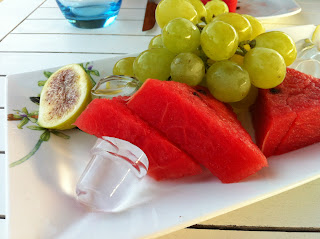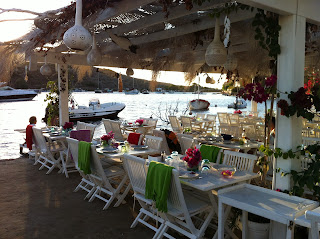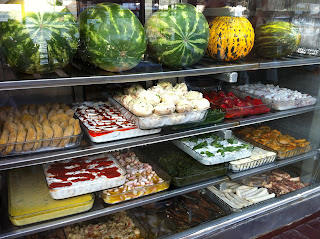
Finding yourself in Istanbul is like crossing New York City with a Muslin Mosque. The population of 13 million seems to condense in obscure, corridor-streets filled with tables selling you stuff. Money has been reduced to a simple barter system. And just when you get your bustle on, the call (Adhan) blares through the loudspeakers fixed above the minarets and things slow down. The Red Apple of the Turks proudly flies the Turkey flag everywhere, reminding me of the American streets right after 9/11. Huge red flags blows over the dusty facade like maraschino cherry in caramel ice-cream.

Our first culinary stop was at a deli-buffet called
Namli Gurme. At first we thought it was a gourmet supermarket. Very confused, we were explained by pointing hands and one-word English that we are to chose some of the pre-made dishes. They put it all on a plate and bring it to you where you have chosen your table to be. We came here twice, with the second time, being more savvy, we ordered the kebab. We thought it was just the meat, but it was prepared as a full meal with a wonderful complimentary salad. I like being able to see all the various dishes. A visual menu is very helpful in a country where some of the letters aren’t even in your alphabet. However you don’t really have an idea who much your pickings will cost. So I’m thankful that the Turkish Lira was half to the US Dollar and the prices were not inflamed to match it.
The next culinary experience,
Kazancılar Kebapçısı, was a kebab house overlooking the Kalamış marina. This is where the international palette meets traditional Turkish cuisine.
We started with Raki (A rice hard liquor that is mixed with water and ice. The water turns milky. The taste is strong with anise, very refreshing, but somewhat tasting of cough mixture. This is sacrilege for me to say this by the way).

Then the meze’s were presented by waiters who continued the whole evening with vigorous serving and clearing. New plates and cutlery kept coming as going. The trick I learnt here, is that you sample just a little because many courses and dishes followed.
The meze list, which could also mean: how many different ways can I serve you eggplant:
Ezme (Mixed vegetables chopped, blended with pepper paste)
Haydari (a thick dip and spread made from strained yoghurt)
Karışık Turşu (Mixed pickles)
Közde Biber (Roasted red peppers)
Közlenmiş Al Biber Turşusu (Winter roasted red peppers)
Kuru Cacık (Süzme yoğurttan) (Cucumber yoghurt)
Muhammara/Acuka (walnut, red pepper, pepper paste, spices)

Patlıcan Salata (Eggplant Salad)
Semizotu (Summer purslane salad with yogurt)
Yoğurtlu Kızartma (Yogurt something)
Dolma (vine leaves stuffed with rice/meat)
Çoban salatası (tomato, cucumber, onion, peppers salad)
Çiğ köfte (raw meat patties, similar to steak tartare and lettuce)
Haşlama İçli Köfte (Meatballs)
Beyaz Peynir (Feta Cheese)
Following with the main course with a one communal sizzling grill pan raised on a tripod filled with kebabs and meats such as ribs, chicken and lamb. Acılı Adana Kebap is what they are well known for. It was grilled deliciousness!
After that the desserts: Fıstıklı Kadayıf (Pistachio baklavas assortment) and Turkish coffee. We were taught how to tell your fortune with your Turkish coffee. As you know, with Turkish coffee there is a moment where you stop drinking, before the grind sludge starts tricking on your tongue. That’s when you wait for the cup to cool completely. You put the saucer on top on the little cup. You keep it like this until you get to the fortune teller. They will then flip the two over. The coffee sludge at the bottom would have dried and from this markings they weave your story.

The next restaurant took us by surprise. We were in the Istiklal district browsing the art Galeri Nev and continued up the stairs to come to
360 İstanbul Restaurant. It was just perfect timing. The sun was setting, it was warm and clear skies. So to enjoy this rooftop seating, these elements were essential. The menu was a graphic designer’s delight, and as true design attaches itself to sales, the actual menu was available for purchase. We hadn’t planned on dinner, so we just enjoyed a cocktail and marvelled at the city view from above.

The following day, our travels took up north to the Kariye Museum (Church of the Holy Savior in Chora). A very old church featuring some of the most breathtaking Byzantine Art. Next to the museum is one of the top rated restaurants in Istanbul called
Asitane. The delicate decor sets the scene for the menu items to really shine. White table linens, little dried purple flowers with inside or outside seating was just wonderful. Each dish triples the senses with sight, smell and taste. A little visual artwork, that doesn’t disappoint when savored. We had the stuffed melon entrée, where the melon was the bowl and a tasty meat mixture was beautiful arranged inside. A fresh walnut and pomegranate salad starter was very complimentary.

Keeping with the list of top restaurants there are two left of the list to recommend. X Restaurant and the local Fenerbahçe Spor Kulübü.
 The X Restaurant | Bar was up towards the Tower of Galata. Using local transport, like the Beyoğlu Tünel we got the hill and navigated by foot the remainder to the restaurant. The restaurant was a little tricky to find because you enter by the building to the IKSV’s (Istanbul Foundation for Culture and Arts). X was a very chick place. You could see this place would feature as a Manhattan much be seen at gig, with heels and black tie (although they accepted us in tourist guise). The food taste here was of experienced chefs schooling. Just a few ingredients, on beautifully painted plates, making every ingredient add to the flavour. Nothing more needed and nothing left out. We came right as they opened on Saturday for lunch and were fortunate to have the entire place to ourselves. Loved it! After lunch it is a great digestive aid to walk so we ventured down the hill were enjoyably entertained by the corridors of little shops and music stores.
The X Restaurant | Bar was up towards the Tower of Galata. Using local transport, like the Beyoğlu Tünel we got the hill and navigated by foot the remainder to the restaurant. The restaurant was a little tricky to find because you enter by the building to the IKSV’s (Istanbul Foundation for Culture and Arts). X was a very chick place. You could see this place would feature as a Manhattan much be seen at gig, with heels and black tie (although they accepted us in tourist guise). The food taste here was of experienced chefs schooling. Just a few ingredients, on beautifully painted plates, making every ingredient add to the flavour. Nothing more needed and nothing left out. We came right as they opened on Saturday for lunch and were fortunate to have the entire place to ourselves. Loved it! After lunch it is a great digestive aid to walk so we ventured down the hill were enjoyably entertained by the corridors of little shops and music stores.


Finally the last restaurant I will review is at the Fenerbahce Sports Club. I guess for members of the soccer-crazed Fenerbahce fans, this place also was fantastic. Although one interesting observation, we came here twice. Once with local Turkish people who ordered for us and the second time on our own. The first time, we never even looked at the menu as we were told to put it down, and we would be taken care of. So I’m not sure what was ordered, but it started with raki, meze’s, then kebabs, followed by dessert and Turkish coffee. This really is the flow of the menu in Turkey. The second time, we tried to repeat this first experience, but we could not. Looking at the menu, we did not have the insight, or translation that our hosts had. Later I learned that for example, when you order Raki, to add to the flavour, you should also order white melon, Feta cheese and baba ghanoush. This combination seems a local secret.

With our culinary explorations we noticed that there was a whole extra section on the menu for order. Nargile. Smoking pipe with cafe’s dedicated to this and pans used for coals.
Walking the streets, I loved seeing pineapples on sticks. What a great idea as opposed to lollypops. Also lots of shawarma places, so you could get your meat fix! But then there were the street eats, as in New York of pretzels. Some corn, which was okay.

In Turkey, you don’t really find supermarkets or grocery shops like a Spar. I guess because all the cooked food, like meat is to found at one of the many kebab places or shawarma venders, and raw food is found at the markets called bazaars. People don’t seem to drink any tap water, so bottles of water are on sale everywhere. I must say after 3 or 4 days of eating a restaurant meal for every meal, I had sensory overload. So a bottle of water, beautiful figs and peaches bigger than oranges served as amazing food. Having an ice-cream on hot days is something different, for its not ice-cream, like gelato. Its called Dondurma and its more like a cold, gooey nougat. Its served from a long-handled paddle and the barrel. I guess you are meant to do this with a cone, but since I find the cones wheaty-waste, I go with cup and spoon. It would break my plastic spoon every time.

The last mention will be about the bazaar. For this was something of paleo delight. Raw whole foods, spices, teas and baked things, and things and things in general. I enjoyed the Egyptian Bazaar/Spice Bazaar the most, called so for goods brought from Egypt a few centuries ago. This market has been going for the past 350 years and is smaller and cheaper than its large tourist part, the Grand Bazaar. Here I bought Turkish saffron, curries, Ottoman spice and dried peppers. I also enjoyed the Lokum (Turkish delight) and could loudly pronounce, I’m eating Turkish delight in Turkey! We samples many types of delights, with my favourite being the one made with rose water. We had dried figs wrapped in walnuts, and many types of baklava’s including chocolate baklava.




































































